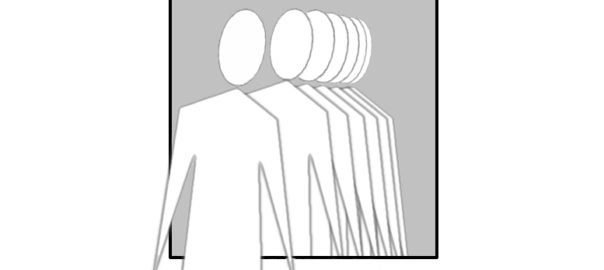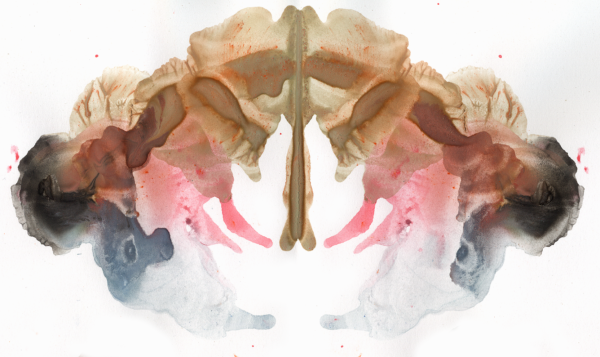Political polarization has been on the rise over the past few decades. This division has only intensified during Trump’s presidency. In today’s climate, the discussion of our political differences appears nearly impossible. This post will explore how the interplay of beliefs and values shapes our political positions. We will see how our quest for certainty can result in adopting polarized positions. Yet normal conflicts between values undermine our confidence in taking such absolute stances on issues. “True believers” resolve this dilemma by compartmentalizing their conflicting values. Additionally, they seek refuge externally, embracing dogma, cult, and authoritarian leader for their longed-for reassurance. This post will expand upon this rather compact summary for a more complete understanding of polarization.
Our Quest for Meaning and Security
First, our political principles do not exist in a vacuum. Rather, they are part of an overall outlook on life that also encompasses culture, society, spirituality, recreation, and occupation. Our various beliefs, attitudes, opinions, and values generally hang together in at least a somewhat coherent fashion. This system helps us make sense of the world around us, anticipate relevant events, and plan accordingly. We rely on it not only to find meaning and purpose, but also to achieve a sense of security.
Beliefs and Values
Here, it is helpful to distinguish between beliefs and values. Our beliefs concern how we see things being, whereas our values are about how we see things should be. Our political positions concern the discrepancy between what is and what should or could be. If the current situation is consistent with our values, we support the status quo. This conservative stance by no means implies complacency – we can be quite vigilant in preserving the current order. And when the present doesn’t measure up to our ideals, we promote change. This can be progressive, in trying something new, or regressive, in going back to the old ways. Through this process, our systems of values and beliefs shape our various political opinions, attitudes, and policies.
Diversity Breeds Insecurity
With the diversity of beliefs and values, how can we be confident in our own? And with severe polarization, we disagree sharply in both our values and our beliefs. This makes for considerable conflict and confusion, thus threatening our sense of security. In the face of this situation, we long for certainty.
Logic and Our Search for Clear-cut Answers
Threats to our security are not just external – they can be internal, as well. Our outlook on life bolsters our sense of security by providing a consistent, straightforward guide for making choices. We generally like clear-cut, logical answers – true or false, right or wrong, good or bad. Logical analysis is custom-designed to deliver the goods, in either-or terms. And when we can all agree on the basic assumptions in a logical argument, we can usually agree on the conclusions. Such are the ingredients of an orderly, productive society.
The Initial Assumptions – Therein Lies the Rub
The main challenge to our societal ideals lies outside the realm of logic – actually, prior to it. Logic does not create something out of nothing. In order to use deductive reasoning, we require some initial statements to apply it to. These premises are basic beliefs which we presume to be true. With no logical proof of their validity, we believe them because they make sense to us and others whose opinions we respect. With polarization, we often disagree on the basic premises underpinning our arguments on a particular policy. Usually these assumptions go unstated, resulting in a stalemate in discussions.
Agreeing on the Facts
Another problem is agreeing on the facts. We’d all like to think that we share the same knowledge base in debating our positions on issues. After all, facts are facts, right? Yet political developments highlight this challenge. For example, Kelly Ann Conway proposed “alternative facts” in justifying the claim that President Trump had record attendance at his inauguration. While hardly an expert in epistemology (i.e., the philosophical study of how we know things), she backed this position by questioning how we can know anything with certainty. More recently, the distinction between anecdotal and scientific knowledge has emerged in the battle against COVID-19. All this highlights the need for consensus regarding “rules of evidence” for determining fact. (I plan to take this up in an upcoming post, with the working title of “Knowledge: Anecdote, Analogy, and Logic”.)
How Logic Speaks to Values – Or Not
Values present an even more daunting challenge to a sense of security that rests on a foundation of certainty. In the world of philosophy, the logical empiricists are rather dismissive of values, or ideals. Purists consider them to be non-sensory phenomena (or nonsense, for short?), and thus unworthy of logical inquiry. (Scott Adams has delivered a rather pithy commentary of their bias in Dilbert.) By embracing the value of objectivity, they appear quite willing to relegate the topic of values to the more subjective ethicists. The resulting separate study of beliefs and values complicates our efforts to understand their interplay in creating polarized political positions. Still, we must proceed.
Values in Conflict – Incidental and Paradoxical
All this goes to say that values do not lend themselves well to logical analysis. While deductive reasoning offers “either-or” conclusions in establishing facts, “both-and” resolutions appear more appropriate to values. This situation is particularly relevant when values are in conflict – as they frequently are. These conflicts may be incidental, arising randomly in specific situations. Yet, quite often certain values are inherently opposed to one another. These include order vs. spontaneity, individual freedom vs. the common good, adventure/risk vs. security, living for today vs. planning for tomorrow, and being-for-self vs. being-for-others. Such polarities in values serve as the basis for much polarization. You can probably recognize how various political controversies involve one or more of these dualities.
The Issue of Paradox
If logic doesn’t solve the problem of conflicting values, where do we turn? Another option is to view our conflicts between values not as problems to be solved, but as paradoxes to be accepted. Here, I might quote from my doctoral dissertation over years ago:
Despite (and perhaps because of) our scientific inventions and discoveries, humans confront paradoxes without adaptive solutions. We are capable of projecting ourselves into the past or future, yet remain tethered to the present. We contemplate the infinite, yet cannot escape our own mortality. We are determined by our histories, yet choose our future. We are our bodies, yet we have bodies. These are all features of the human condition for which science provides no solutions. . . . It is here, where science falls short, that art speaks and perhaps comforts.
Robert Daniel, Ph.D., 1986
An Example of a Paradoxical Duality of Values
A common saying offers some insight into the dilemma posed by one such paradoxical duality: “You can’t have your cake and eat it, too.” This simple statement embodies the tension between enjoying life in the moment and planning for the future. There is one significant flaw with this assertion, in that it considers only a binary choice, with either-or options. It overlooks a middle ground: “You can halve your cake, eat one half now, save the rest for later.” While flawed, the original saying conveys the opposite extremes that characterize polarization. Furthermore, the altered version suggests a “both-and” resolution involving a trade-off between the two ideals.
Political Implications of This Paradox
In politics, this issue plays out in the decision to get immediate relief from deferring payroll taxes or to continue full funding of Social Security for our futures. It also applies to the threat that the extraction of natural resources poses to future pollution of our environment. Our next generation will judge us by how we leave the earth, their inheritance. To listen to Greta Thunberg, we’ve already been indicted (and rightly so, I might add).
Links to Other Examples
There are many other examples of paradoxes in values that defy logical solution, as I have pointed out in Living Rationally with Paradox: Staying Sane in a Crazy World, or Trying to Force a Round Peg into a Square Hole? Since humor draws on paradox, it is not surprising to find excellent examples in the comic strips. Bill Waterston is a master at exposing these existential dilemmas, as he has done in Calvin and Hobbes. I am again providing links to his commentary on the polarities of Individuality vs. Belonging, Order vs. Freedom, Adventure vs. Security, and Living in the Present vs. Planning for the Future. These present examples of basic conflicts between values that defy logical solution, which have political implications.
Polarization: The Politics of Extremes
Yet another example of polarization comes straight from the political sphere. Here, former presidential candidate Barry Goldwater famously stated: “Extremism in the defense of liberty is no vice. And moderation in the pursuit of justice is no virtue.” Ultimate liberty means having no limits, and thus no rules or order. Without restraints, those in power are free to do as they please. As Lord Acton noted in the 19th Century, “Power tends to corrupt, and absolute power corrupts absolutely.” Thus, the powerful get their way, creating injustice for others. Goldwater was able to compartmentalize freedom and justice so as not to recognize this inherent conflict. And many other politicians are doing the same with the various paradoxical dilemmas that underlay our political polarization.
Paradox: Where Logic Falls Short
As I suggested through my two examples, polarization arises out of our tendency to view dualities in either-or terms. Deductive logic emphasizes such binary solutions to our problems. This, along with the inductive reasoning of the scientific method, has promoted major technological advances. Yet logic falls short when it comes to paradox, which by definition defies logical solution. We cannot totally have it our way for both savoring the moment and building a nest egg for tomorrow. Nor can we have absolute freedom and total justice in our society. Of course, this also challenges Madison Avenue’s sales pitch that “you can have it all.” So, where does that leave us?
Paradox: A Challenge to Certainty
Our alternative resolution to paradoxes is acceptance. This involves recognizing that we cannot totally attain both ends of polar dualities. Rather than the polarized choice between the two extremes, we can resign ourselves to a trade-off between the two. We can opt for some of both, but not all of either. But just where do we draw the line? Well, this is where ambiguity sets in. As much as we might want definitive answers, these choices are generally a matter of personal preference. (More on this later.) While that might relieve us of the burden of proving ourselves right, it leaves us on shaky ground with our sense of security. No straightforward, clear-cut answers here – only a debate on the relative merits of a proposed policy.
Finding Balance between the Paradoxical Values
I have proposed one basic guideline in my previous post, Muddling down a Middle Path: Wading through the Messiness of Life. Actually, the title aptly summarizes my message, which draws on the Buddhist principle of the Middle Path. The general rule of thumb is that the middle ground works out better than polarized extremes of the spectrum. Simple, no? Well, there is one slight complication: there can be a wide range of healthy, adaptive positions in the middle. This leaves plenty of room for honest differences of opinion.
Balancing Logic and Paradox
Earlier, I expressed regret for how the separate studies of logic and ethics complicate our understanding of political opinions. Instead, I suggest that logical determination of facts and tolerance for conflicting values ideally complement one other to achieve informed political opinions. This integration utilizes both objective and subjective perspectives for a deeper appreciation of our political differences. In doing so, this model views science and the humanities as complementary, rather than opposing forces.
In Praise of Ambiguity and Uncertainty
Political dialogue based upon the above principles support greater tolerance for our differences and less judgmentalism of one other. Thus, we can have honest disagreements without each declaring ourselves right and others wrong. We can broaden our perspective by considering ideas and values other than our own. We can stand in awe of this complex and diverse world, especially since we can’t entirely comprehend it in logical terms. So, why not embrace life’s ambiguities? Indeed, Alan Watts recommends this in The Wisdom of Insecurity, a spiritual book that transcends particular religious traditions. So, what’s not to love?
The Threat to our Sense of Security
There’s just one catch, though. Remember how we addressed our desire for certainty to insure our sense of security, especially in contentious times? Well, conflicting values challenge our having straightforward, clear-cut answers. Do you recall that game of Jenga, involving removal of building blocks from a tower? We can remove only so many select blocks before the structure topples. Well, that illustrates the fears that some have about giving up their right vs. wrong, black-and-white thinking. It is indeed ironic that seeking this internal certainty fosters the polarization that is so divisive to society. While we may seek certainty to reassure our sense of security, the resulting polarization ultimately threatens our actual security.
The True Believer
Seeking certainty for a sense of identity and security is by no means a new concept. In The True Believer: Thoughts on the Nature of Mass Movements (1951), Eric Hoffer coined the term, “true believer.” Since his profile of this phenomenon remains valid, I will borrow his term in discussing seekers of certainty.
The Illusion of Absolute Certainty
This illusion of certainty and security is not achieved without some serious mental gymnastics. True believers commonly deny, rationalize, distort, and suppress evidence contrary to their polarized positions. Yet their really problematic challenge is more internal – that of conflicts among the very values they endorse. I have proposed that we optimally have a balanced trade-off between opposing values. These include law-and-order vs. freedom, individualism vs. the common good, and adventure vs. security. Many true believers view most all these values positively. They even treat them as dogma – absolute ideals, written in stone, never to be violated. Maintaining this illusion, though, requires not seeing them in conflict with one another. Goldwater, for example, was apparently able to achieve this with regard to liberty and justice. Such is the defense mechanism of compartmentalization.

Compartmentalization
Compartmentalization involves erecting internal firewalls between contradictory positions which we hold. We consider each of the opposing sides one at a time, so that we don’t recognize the contradictions. When we delve more deeply into our policies promoting one ideal, we encounter how it limits its complement. For instance, we might promote freedom by allowing business owners to select their customers by whatever standard they choose. When they do so on grounds of race, religion, or gender, this discrimination infringes on justice for these groups. With compartmentalization, each value is addressed independently, allowing sequential coexistence of opposing polarized positions. This defense worked so well for Barry Goldwater, that he didn’t recognize the contradiction within two consecutive sentences.
A Sea of Uncertainty
So far, I have argued that limitations of logic, relativity of conflicting values, and ambiguity of paradoxes all challenge certainty in our convictions. Earlier, I had noted how our choices among various competing values boil down to personal preference. With so many viable options, our decisions can feel rather arbitrary. This only further diminishes our sense of certainty. If we base our security on such certainty, we won’t feel particularly safe. Then, we are likely to look outside ourselves, to rely on external sources for clear-cut answers.
Finding External Sources of Certainty
External sources of doctrine, group, and leader may promise straightforward answers to contentious political issues. These areas correspond to three moral values proposed by psychologist Jonathan Haidt, in his Moral Foundations Theory. Here, he supplemented the usual standards of fairness and harm avoidance with sanctity, group loyalty, and allegiance to authority. Each of these three additions can reassure true believers of certainty in their polarized convictions.
Sanctity Backed by Religious Doctrine
Sanctity involves an ethical code emphasizing purity of thought and action, usually based on religious doctrine. Typically, the dogma affirms the absolute truth of its tenets. These are seen as trumping other values that may conflict with them. The Catholic Church’s claim of papal infallibility is but one example. With such dogma superceding other viewpoints, true believers can rest assured that their values and beliefs are absolute truths.
Loyalty to Group
Loyalty to the group is another external support that enables the illusion of certainty. True believers can achieve a sense of personal identity from being a member of a larger group. The pressure for group conformity, though, discourages the other principle component of individual identity – one’s uniqueness. This is consistent with Hoffer’s notion that mass movements actually discourage self-affirmation. Any sense of uniqueness is shared with the whole group and is in opposition to other groups. This establishes an “us vs. them” mentality, which lies at the heart of polarization. While this solidifies the true believers’ sense of meaning and purpose, it envisions a more hostile world. This ominous perspective likely leads them to hunker down in their polarized beliefs and values. It also leaves them even more dependent upon their external support system.
Allegiance to the Leader
Finally, true believers gravitate toward charismatic leaders who lay claim to having all the answers. They thus obtain their sense of value vicariously, through identifying with their leader. When the Wizard says to pay no attention to the little man behind the curtain, they oblige. No questions asked.
Dogma, Cult, and Authoritarian Leader
The values of sanctity, group loyalty, and allegiance to the leader present a formidable force for polarization. In their extreme versions, they promote rigid dogma, cults, and authoritarian leaders. This combination leaves the true believer almost impervious to influence from sources outside this triad. Logical reasoning seldom penetrates their political polarization – they simply are too well defended. Yet the authoritarian leaders and the proponents of the “us vs. them” dogma are even more resistant to change. They are simply unwilling to give up their power. This leaves the true believer as the weak link in the movement. My upcoming post, Bridging the Great Political Divide, will address the difficult challenge of engaging the true believer.
The Broader Perspective on Polarization
Prior to this last section, we have addressed political polarization primarily on the individual level, in basically psychological terms. It is when we step back and examine it on the larger political scale that we realize the potential for real danger. Then, we see political cults that poses challenges to our democracy. Factions at both poles of the political spectrum get locked into dysfunctional vicious cycle patterns. As I addressed in Vicious Cycle Roles on the Societal and Political Level, a common political pattern involves law-and-order conservatives and bleeding heart liberals clashing on how to handle major groups. Where the former see threats to our way of life, the latter see society’s victims. In a polarized society, there is little room for a nuanced perspective on the group in question. As the saying goes, “You’re either for us or against us.”
Where We Stand Today
We appear to be in one such vortex today, in the shadow of George Floyd’s tragic death. We could characterize the 2020 presidential race as a classic battle between law-and-order and bleeding hearts. That, however, would be a gross simplification – and wrong. On the one hand, Donald Trump’s position is polarized and dogmatic. He panders to his base by promising to quell and “dominate” the unrest and violence. If he has made any distinction between peaceful protesters and anarchists, it was only a passing footnote. He has excused bad cops for their “choking” under pressure and characterized right-wing vigilante militias as patriots. On the other hand, Joe Biden has highlighted the distinction between peaceful protesters and vandals, looters, and rioters. He seeks reform of our imperfect institutions, not their dismantlement. He seeks unification and healing, while Trump pursues division and dominance.
A Statement of Disclosure
I admit that I am not providing “fair and balanced” coverage in focusing on the polarized right. In my defense, I do so because that is where the power is. And as Lord Acton noted, corruption soon follows. Whether that be voter suppression, violations of the Hatch Act, seeking foreign assistance in elections, or other abuses, recent history bears that out. Such violations are not currently so apparent or menacing on the polarized left. Yes, there has been destruction and violence by a left-wing fringe, which warrants punishment. I fear that any harm to life and property, bad as it is, will be overshadowed by the law-and-order measures taken to suppress dissent. I like to think that I would challenge the political left similarly for any abuses comparable to the polarized right’s. When the pendulum of power swings in its direction, I could well be tested.
Behind the Scenes – Conspiracy?
I have my doubts whether the corporate/governmental complex, backed by their Super PACs, special interest lobbyists, and biased think tanks, will give up power willingly. They are just too invested in their pursuit of power, property, prestige, and privilege. Yes, this offers an alternative to the Deep State conspiracy in describing the behind-the-scene power structure. Still, I’d assert that it offers vastly better documentation than QAnon, Alex Jones, Fox Media, Breitbart, and OAN. But don’t take my word for it. Check out Common Cause, Public Citizen, and other lobbying groups serving the public, rather than special interests.
Where to from Here?
Hopefully, I have offered some clarity on the issue of political polarization. The 2020 ballot box has affirmed democracy over polarized dogma, autocratic leadership, and true-believer cult followers. Still, the gains are not written in stone. To paraphrase and extend a famous saying of uncertain origins, “The price of freedom [and justice, for that matter] is eternal vigilance.” There still needs to be major reckoning and healing before we can restore collaborative governance. We may not be able to reach die-hard true believers of the polar extremes, but we might try a fresh approach. Watch for my upcoming post, Bridging the Great Political Divide, where I will introduce “verbal judo.” If nothing else, perhaps we can reach enough independents to attain the critical mass needed for true reform. Stay tuned, keep an open mind, breathe deeply, and hang on for the roller coaster ride of a lifetime.










